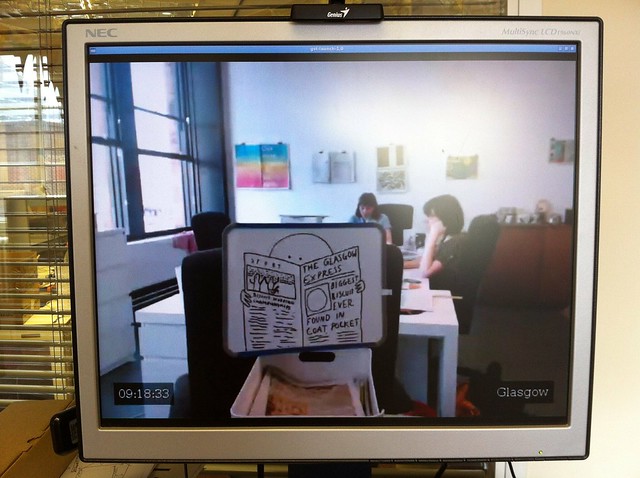Connboxes, project looking glass, and ambient videopresence in 2013
I've had this post in a tab on Chrome on my iPad for yonks now, and finally this weekend I finally got round to reading the lovely BERG piece about the Connbox project they did with Google back in 2011.
There's a reason the post lingered in Chrome for as long as it did - it's a typical Matt Jones behemoth of a post, and it takes a good 20 mninutes to read through fully and watch the videos to fully understand the nuances of the prototype physical products they're building.
Carve out 30 minutes
If have any passing interest in product design though, or how people relate to each other through computers, I'd recommend making the time to work through the piece - it's easily one of the most satisfying pieces I've read in some time, especially when you bear in mind this was all done in 2011.
Ambient videopresence in 2013
Since this work was originally done, Google Hangouts has been launched, and if there are any remote workers, the majority of tech companies I have friends in use daily.
What's also interesting is that we're seeing some of the ambient qualities of video being picked up outside of top secret projects like this:
It's not uncommon to have long running Google hangouts in use for staff to dip into, like extremely high bandwidth IRC now. There are even hubot plugins specifically to make this easy to do], from more commoon Campfire or IRC chats used in tech teams.
As the price of these gadgets heads ever downwards, you're also seeing similar projects appear as well, with full instructions for setting these up yourself. Tom Taylor's recent piece, Project Looking Glass is a fantastic post to look into if any of this has piqued your interest, as it explains how he did this for hook up the Glasgow and London offices of Newspaper Club.
Taking the digital out of video conferencing
One thing that really struck me where when reading both Tom and Matt's piece was how all the high tech gubbins affords much more analogue, interactions with each other again.
Watch this video here, showing a) using scribbled notes to communicate textually, and crucially toward the end, how they use a fleeting glances at the screen to find cues to speak to communicate with each other.
You can see the same with Tom's looking glass too:

Reading this post has inspired me somewhat to pick up a Raspberry Pi and see if I can get Herenow working on it, to see what I can learn about using small, internet connected boxes and physical presence.
There go the next few weekends…
Further reading
- Connbox - Prototyping physical presence
- Project Stargate - always on video connection for remote offices
- Project Looking Glass - Tom Taylor's variant, made from Raspberry Pis, spare monitors, and cheap webcams, for about £150.
- Matt Web's Glancing - an early, fascinating experiment in capturing the fleeting, ambiguous quality of real life interactions.
- HereNow - A toy app I've been building, to allow people to automatically declare their presence to small groups of friends in spaces served by wifi.